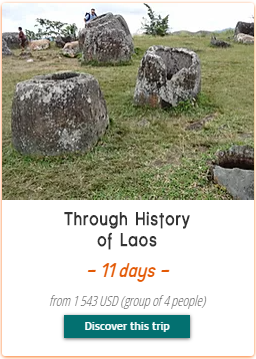Laotian temples and the history of the Wat Xiengthong in Luang Prabang
- Charly Renaudin

- Mar 23, 2018
- 2 min read
Updated: Jul 17, 2020
Architecture of the temples and pagodas in Laos
The structure of religious buildings in Laos is partly inspired by Khmer architecture. Their style may vary in different parts of the country, but remain quite close. The pointed roofs, made of flat tiles, descend towards the ground in an elegant curve. Walls and pillars are covered with gilding and red paint. Many frescoes evoke the life of Buddha. On and around the temples, statues of naga watch over the monuments. The temples and pagodas - also called Wat - are divided into several buildings: the chedi (reliquary), the bôt (hall of sacred prayer), the viharn (meeting and prayer room), the sala (pavilion for resting and other activities), the haw klawng (drum tower), the haw rakhang (bell tower) ...
The Wat Xienthong temple in Luang Prabang
Wat Xiengthong was built in the 16th century by King Say Setthathirath from 1559 to 1560, which is situated close to the Mekong River and about 300 meters from the Nam Khan River.
Wat Xiengthong is one of the oldest and the most beautiful monasteries in Luang Prabang which is praised as the architectural gem of Luang Prabang for its historical and artistic values. This temple was especially taken care of by King Sisavangvong and Sisavang Watthana following the restoration and preservation by the great monk Kham Mao in the temple.
Wat Xiengthong is a symbol of the great historical importance. This magnificent masterpiece is a representative of the typical Laotian architecture, demonstrated by the Sim (called Phutthasima), the Triptaka library, the worship hall, the pagoda and the Buddha image statues.
The Sim of Wat Xiengthong was restored in 1928 and during 1952 – 1960. The construction of a new Hor Kong was carried out at the same time as the construction of a funeral chapel for King Sisavangvong which started in 1962. The funeral chapel was designed by Chao Manivong Khattiyarath (the national artist on architecture year 2010) and the carving was carried out by Phia Tan (the national artist on sculpture year 2010), both of whom are the carvers of Luang Prabang at that time.
#travel #traveling #vacation #visiting #trip #holiday #vacation #travelling #tourism #tourist #traveller #explore #travelblogger #traveltheworld #traveladdict #adventure #paradise #visiting #aroundtheworld #trippy #trip #travelpics #travelpic #discovertheworld #travel_captures #travelblog #frenchtravel #luxuryexperiences #goodtime #picoftheday #frenchtraveler #travelwithme #enjoyyourlife #wanderlust #adventureseeker #doyoutravel #travelmore #goexplore #wonderfulplaces #openmyworld #lovetotravel #adventurethatislife #roamtheplanet #travelbloggers #travelblogging #tblogger #thattravelblog #wanderer #travelholic


































Comments